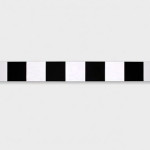Biography
Mary Corse was born in Berkeley, California, in 1945. In 1963 she received a BFA from the University of California, Santa Barbara, where she studied psychology, and in 1968 an MFA from the Chouinard Art Institute, Los Angeles (now California Institute of Arts, Valencia), where she studied painting, philosophy, and Tibetan Buddhism. In the mid-1960s, she produced white monochromes on shaped canvases and Plexiglas constructions illuminated by fluorescent light bulbs. One such work, Untitled (Space + Electric Light) (1968), is a glowing cube made from Plexiglas, neon, and tesla, a high-voltage, low-current energy system. In 1968, she began incorporating glass microspheres, tiny prismatic beads often embedded into highway pavement for their reflective properties, into her paintings and blended them with different shades of acrylic, a technique that still forms the basis of her work.
Corse is often considered part of the Light and Space movement, an otherwise male-dominated movement that developed in Southern California in the 1960s and includes Larry Bell, Robert Irwin, James Turrell, and Doug Wheeler. However, Corse maintains that, at least in the 1960s, she was neither part of the group nor influenced by their work. Nonetheless, this set of loosely affiliated artists worked with the medium of light, using reflective or transparent surfaces like resin or Plexiglas, or specific materials or technologies developed for the car or aviation industries. In the late 1970s and early 1980s, Corse briefly switched her production to large paintings with heavy slabs in dark clay, but soon returned to painting and incorporating microspheres into the medium. Her technique transforms opaque and blank Minimalist canvases into surfaces on which hard-edged stripes or blocks and gestural brushstrokes seem to appear and disappear. The visual instability of Corse’s canvases underscores the artist’s conviction that perception is the most important aesthetic act and that these seeming accidents of perception are more interesting than accidental gestures by the artist on the canvas. This position subtly undermines the tenets of Minimalism. While that style tends to refute gestural works, Corse’s canvases incorporate both gesture and chance into an otherwise Minimalist framework.
Corse’s work has been the subject of numerous solo exhibitions at venues such as Ace Gallery, Los Angeles (1987, 1994, 2001, 2009, 2012); White Cube, London (2011); and Lehmann Maupin, New York (2012). Her work has also been included in notable international exhibitions such as the Pacific Standard Time shows Phenomenal: California Light and Space, Museum of Contemporary Art San Diego (2011–12) and Crosscurrents in L.A. Painting and Sculpture, 1950–1970, Getty Center, Los Angeles (2011–12), and Martin-Gropius-Bau, Berlin (2012). It was also featured in Surface, Support, Process: The 1960s Monochrome, Guggenheim Museum (2012). She is the recipient of numerous grants and awards, including a National Endowment for the Arts fellowship (1975); Theodoron Award, Guggenheim Museum (1971); and Cartier Foundation Award (1993). She lives and works in Los Angeles.

 White Black 9 Bands Beveled
White Black 9 Bands Beveled